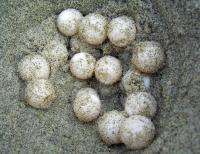May 25, 2011 report
Turtle embryos move to bask in the sun

(PhysOrg.com) -- Turtles, like the majority of reptiles, are unable to regulate their own body heat and use their environment to control their temperature. In order to stay warm, reptiles will bask in this sun. Researchers believed that this was a learned behavior, however, in a journal published in the Proceedings of the National Academy of Sciences, Wei-Guo Du from the Chinese Academy of Sciences have found that this basking behavior starts while the turtle is still in the egg.
Du collected 260 Chinese soft shelled turtle (Pelodiscus sinensis) eggs from local turtle farms and placed them in jars and warmed them with a heat lamp. The side of the egg where the heat lamp was placed created a temperature increase of one degree Celsius. With a combination of candling (the use of light through a shell to see the embryo) and a partial removal of shells, Du discovered that the embryos seemed to sense this and moved to the side of the egg closest to the heat. When the light was moved, the embryos would follow to the warmer side.
In another, more natural experiment, Du used 540 eggs and buried them in natural nest settings like a sloping river bank or a flat field. When the eggs were placed into the nests, he arranged them so that the embryos were in the uppermost part of the egg. After about 20 days, the embryos which had been buried on the slop had moved to toward the bank while those in the flat field, which had the sun shining from directly overhead, had stayed in the same position.
This ability to move and control their temperature can be a big difference for the young turtle. A change in temperature for the turtle embryo by only one degree Celsius can mean it will hatch 4.5 days sooner and reduce their risk of becoming a meal for egg predators. This ability to determine their path also raises an interesting question which Du plans to research. For many reptiles, the sex is determined by the temperature they were incubated in. Those in the 22.5 - 27 degree range are usually male while those at 30 degrees are usually female. The question is, are these turtle embryos then able to determine if they are going to be a boy or a girl?
More information: Behavioral thermoregulation by turtle embryos, PNAS, Published online before print May 23, 2011, doi: 10.1073/pnas.1102965108
Abstract
Mobile ectothermic animals can control their body temperatures by selecting specific thermal conditions in the environment, but embryos—trapped within an immobile egg and lacking locomotor structures—have been assumed to lack that ability. Falsifying that assumption, our experimental studies show that even early stage turtle embryos move within the egg to exploit small-scale spatial thermal heterogeneity. Behavioral thermoregulation is not restricted to posthatching life and instead may be an important tactic in every life-history stage.
© 2010 PhysOrg.com

















